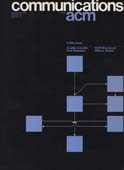November 1973 - Vol. 16 No. 11

Features
Dynamic verification of operating system decisions
A parser-generating system for constructing compressed compilers
A scan conversion algorithm with reduced storage requirements
Experiment with an automatic theorem-prover having partial ordering inference rules
Algorithm 464: eigenvalues of a real, symmetric, tridiagonal matrix [F2]
A note on sub-expression ordering in the execution of arithmetic expressions
Comment on Brent’s scatter storage algorithm
A recurrence scheme for converting from one orthogonal expansion into another
An algorithm for the approximate solution of Wiener-Hopf integral equations
Solving the biharmonic equation in a square: a direct versus a semidirect method



